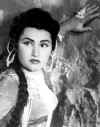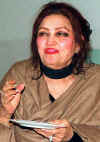|
|
||||
| Home
Feature 'Spirit of India'
Music Music
in Pakistan Health
|
|
|
||
|
the-south-asian.com April 2001 |
||||
|
Page 2 of 5
Music in Pakistan - The Story
of Five Decades by Khalid Manzoor Basra
Pakistani Film Music The power of film, and film music in South Asian society can hardly be overstated. Highlighting the point, Pradip Krishen observes, "Urban environments are cluttered with its signs, filled with its sounds. Its tastes and values spill out to define the very texture of contemporary mass and middle-class culture". This mass culture affects a wide range of activities, but perhaps its most important effect is on music. Film music is the most widely listened to music in South Asia , and since 1931 (the year of the first Indian talkie and the first film song) it has become the dominant force in the construction of musical taste. Film music in Pakistan has largely been dominated by one female voice, that of Noorjehan. She was already in the prime of her career when Lata Mangeshkar made her debut as a play-back singer in Bombay before Partition. Before the era of play-back singing, Noorjehan was an actress-singer. After Partition, she migrated to Lahore with her husband, Shaukat Hussain Rizvi, the famous producer/ director and film-editor who started Shah Noor Studios in Lahore, one of the centres of Pakistani film activity for the last fifty years. The legendary male film singer Muhammad Rafi made his own debut singing a duet with her. Noorjehan may well have recorded more songs than all the other vocalists in Pakistan films put together. Noorjehan has a full throated voice capable of handling lower registers with remarkable command, a quality that makes her equally at ease with Punjabi and Urdu songs. Her versatility has rendered a large number of her songs part of the region’s collective musical memory. The Punjab and especially Lahore have made a significant contribution to the film music of India. One pioneering film music director, Ustad Jhande Khan, was a native of Gujranwala, a town 40 miles north-west of Lahore, and the man who introduced Lata to films, Master Ghulam Haidar, was from a rababi family of Lahore. In the late 1940s many of the leading film personalities, music directors and musicians in Bombay were from Lahore or the surrounding areas. Until the 1960’s Pakistani film music enjoyed a robust period of creative activity with a great number of songs acquiring popularity across the sub-continent. The major music directors of this period (with the noted exception of Khawaja Khurshid Anwar) were mostly rababis. Some of the great names were, Master Inayat Hussain, G.A. Chishti, Rashid Attre, Master Tasadduq, Master Abdullah, Firoze Nizami, Tufail Farooqi and Ustad Nazar. During the early 1960s Urdu film and music quality declined as the result of various factors. The dominance of trend-setting music directors who had experience of Bombay declined and they were replaced by a new and younger generation who tapped the Punjabi film market. Despite the upheaval of Partition and the later ban on Indian films, Bombay film music continued to have a strong impact on the musical tastes of the middle classes in Pakistan through the medium of radio. Farmaishi programmes on All India Radio featured a large number of letters from Pakistan. Radio Ceylon was a trend-setting station that featured commercial advertisements and broadcast long hours of film music, which could be heard all over the sub-continent. Located in Bombay, it pioneered commercial ‘top of the charts’ type programmes (known as ‘Binaca Geet Mala’, sponsored by Binaca tooth paste) and enjoyed huge audience participation. Since it was not subject to the policy restrictions in force on the Indian or Pakistani state radios, which had to broadcast a range of programmes from educational to agricultural, it broadcast Indian film music almost exclusively through the day. Although some Pakistani radio farmaishi programmes using local film music also had a regular audience, the influence enjoyed by Indian film songs was paramount.
Lahore's music traditions & Lahore Radio
|
||||
| Copyright © 2000 [the-south-asian.com]. Intellectual Property. All rights reserved. | ||||
| Home |

